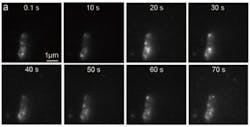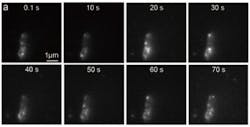Photoswitch captures super-resolution microscopy images at the terapixel level
A team of researchers in the Department of Chemistry at Clemson University (Clemson, SC), working with the University's Light Imaging Facility, developed a nanoparticle "switch" that fluoresces to sharpen the resolution of super-resolution microscopy images that depict small cellular structures.
Related: Fine spectral resolution and single-molecule imaging - fast
Because cellular structures emit light at wavelengths smaller than 400 to 700 nm on the electromagnetic spectrum, they often appear blurred through a light microscope. This constraint is referred to as the diffraction limit, and it occurs because of the wave properties of light. As light passes around structures within biological cells, it diffracts to a point that light microscopes cannot clearly resolve. Single-molecule localization microscopy—a super-resolution method—was invented to surpass this limitation.
"Single-molecule localization microscopy is based on molecular 'photoswitches'—fluorescent molecules that you can turn on and off, like a light switch, to beat the diffraction limit," explains Jason McNeill, associate professor of physical chemistry and the study's principal investigator. "With this imaging method, the sample is imaged one fluorescent molecule at a time and a computer is used to construct an image that is much sharper than what you could get with a regular light microscope."
The catch, however, is that the fluorescence provided by photoswitches is dim at best, with only a slight improvement in image resolution. Single-molecule localization microscopy also requires specialized equipment that can be expensive to obtain.
So, the research team developed an enhanced version of a photoswitch that they call a "buckyswitch," which retains a photoswitch's on-off capability and is 10X brighter. It also allows microscopes to capture images up to the terapixel level.
These photoswitches achieve precision down to approximately 1 nm, which greatly improves the resolution of super-resolution imaging, says graduate student Yifei Jiang. "Also, our method only requires one excitation light source, where conventional super-resolution techniques require two lasers; thus, we have simplified the microscope setup," he says.
Jiang assembled the buckyswitch out of a fluorescent, semiconducting conjugated polymer complexed with a chemical derivative of buckminsterfullerene: a soccer-ball-shaped form of carbon.
By adding the derivative of buckminsterfullerene, called PCBM, to the making of buckyswitches, a "master switch" is formed that regulates the atomic charge of the polymer's segments, thus synchronizing fluorescence. PCBM is able to seize electrons from the polymer segment, giving the segment an overall positive charge. This positive charge reduces the fluorescence of nearby segments, which has a domino effect that turns off fluorescence in the entire nanoparticle.
Once the buckyswitch was synthesized, Jiang tested it in E. coli bacteria, but not before developing a unique growth media for the bacteria. Typically, E. coli is grown in media that is autofluorescent, meaning that it naturally emits light. Without the proper media, the buckyswitch's fluorescence would be obscured by background light.
Jiang then attached the nanoparticle buckyswitches to the surface of E. coli. As hoped, the buckyswitches emitted small flashes of light, which allowed the researchers to determine their precise positions. They then pieced together each flash of light to reconstruct the shape of the E. coli, yielding a super-resolution image.
"We hope this breakthrough will eventually be able to help researchers tackle difficult problems in biology, leading to breakthroughs in the understanding and treatment of disease," the research team says.
The team designed the buckyswitches to work with standard fluorescent microscopes and free software that's available online, making the technology inexpensive and accessible for labs worldwide.
Full details of the work appear in the journal Nano Letters.

